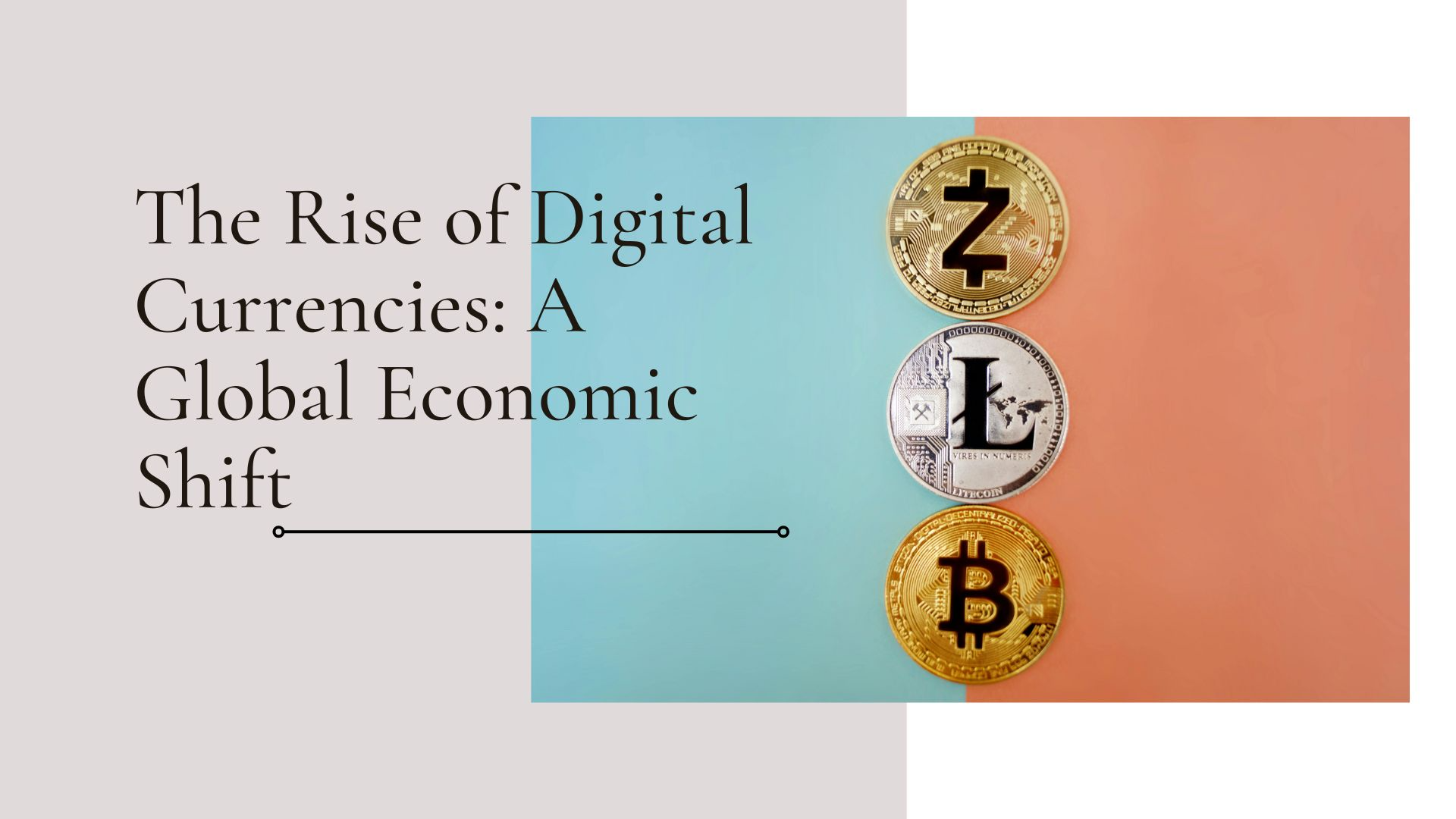The Rise of Digital Currencies: A Global Economic Shift
Digital currencies have moved from the fringes of finance to the center of a global economic transformation. From Bitcoin and Ethereum to Central Bank Digital Currencies (CBDCs), digital currencies are changing how we think about money, how we shop, and even how governments regulate finances. This shift is not just a trend; it’s a fundamental change that could reshape the global economy as we know it. In this blog, we’ll break down what digital currencies are, why they’re becoming so popular, and how they could impact our daily lives in the future.

What Are Digital Currencies?
Digital currencies are forms of money that exist only in electronic form. Unlike cash, you can’t hold a digital currency in your hand, but you can store it in a digital wallet on your phone or computer and use it for online purchases, investments, and transactions. The most well-known types of digital currency are cryptocurrencies, like Bitcoin and Ethereum, which are decentralized and don’t rely on any central authority, like a bank or government. Another rising category is Central Bank Digital Currencies (CBDCs), which are digital versions of a country’s official currency, managed and regulated by that country’s central bank.
Why Are Digital Currencies on the Rise?
Several factors are fueling the rise of digital currencies:
Advances in Technology: The rapid growth of the internet and smartphones has created a world where digital transactions are easy and accessible. Blockchain technology, which is the foundation of many digital currencies, offers secure and transparent ways to manage these currencies.
Changing Consumer Preferences: Many people, especially younger generations, prefer cashless transactions for convenience and ease. Digital currencies align well with these preferences and offer even more flexibility than traditional cashless options like credit cards.
Financial Inclusion: Digital currencies can provide financial access to people in regions without extensive banking infrastructure. With just a smartphone, individuals can store and transfer value without needing a traditional bank account.
Globalization and Cross-Border Payments: Traditional banking systems can be slow and expensive for international transactions. Digital currencies offer a faster, more cost-effective solution, appealing to businesses and individuals working across borders.
Inflation Concerns: In countries where inflation is high, people often turn to digital currencies like Bitcoin to protect their wealth, as these currencies aren’t tied to the value of any one nation’s economy.
Types of Digital Currencies
Digital currencies come in different forms, each with its unique features and uses:
1. Cryptocurrencies
Cryptocurrencies like Bitcoin, Ethereum, and others operate on decentralized networks, meaning they aren’t controlled by any one institution or government. Transactions are recorded on a public ledger called a blockchain, ensuring transparency and security. People use cryptocurrencies as investments, for online transactions, and increasingly as a way to transfer money across borders.
2. Stablecoins
Stablecoins are a type of cryptocurrency designed to hold a stable value, often tied to a currency like the U.S. dollar or a commodity like gold. They offer the benefits of cryptocurrencies (fast transactions, lower fees) without the extreme price volatility. Popular examples include Tether (USDT) and USD Coin (USDC), and they are commonly used in digital trading and payments.
3. Central Bank Digital Currencies (CBDCs)
CBDCs are digital versions of a nation’s currency, such as the digital dollar or digital euro. Unlike cryptocurrencies, CBDCs are centralized and regulated by a country’s central bank. They aim to make digital transactions easier and more secure while providing a reliable government-backed currency in digital form. Several countries, including China, the U.S., and Sweden, are already experimenting with or launching CBDC programs.
How Digital Currencies Are Shaping the Economy
The rise of digital currencies is more than just a shift in how we handle money; it’s reshaping the global economy in significant ways.
1. Transforming the Payments Landscape
Digital currencies offer a faster, cheaper way to make payments. For example, using cryptocurrencies, people can send money to someone halfway around the world in minutes instead of days. This ease of cross-border transactions has made digital currencies attractive for businesses, especially those that operate internationally.
2. Challenging Traditional Banks and Financial Institutions
With digital currencies, people can hold and transfer value without a traditional bank account. This shift could reduce dependency on banks, which may lower fees for consumers and open up new financial opportunities for people without access to traditional banking.
3. Enabling New Types of Businesses and Services
The use of blockchain technology has created new business models, from decentralized finance (DeFi) platforms that offer loans and interest accounts to non-fungible tokens (NFTs), which allow artists and creators to sell digital art. These innovations are creating opportunities in areas that previously didn’t exist.
4. Increasing Financial Inclusion
By offering financial services to anyone with internet access, digital currencies could help close the financial inclusion gap. This benefit is especially meaningful in developing regions, where banking infrastructure may be limited or inaccessible.
Potential Challenges of Digital Currencies
While digital currencies bring exciting opportunities, they also come with their own set of challenges:
Volatility: Cryptocurrencies are known for their price fluctuations, which can be a concern for people who want stability in their assets.
Regulatory Concerns: Governments around the world are still figuring out how to regulate digital currencies, especially cryptocurrencies. Too much regulation could limit growth, while too little could increase risks for users.
Security Risks: While blockchain technology is secure, users are responsible for protecting their digital wallets. Without proper security measures, funds can be lost due to hacking or forgotten passwords.
Environmental Impact: Some cryptocurrencies, like Bitcoin, require massive amounts of energy for mining, raising environmental concerns. However, newer currencies and methods (like Ethereum’s switch to proof-of-stake) are attempting to address this issue.
What Does the Future Hold for Digital Currencies?
Digital currencies are likely to continue growing in popularity and becoming an integral part of the global economy. Central banks may increasingly roll out CBDCs, offering people a way to use digital money with the safety of government backing. At the same time, cryptocurrencies and stablecoins will likely expand their roles in online transactions, remittances, and investments.
As digital currencies become more mainstream, we may see new regulations and technological advancements to make them safer and more accessible. For individuals, understanding digital currencies today could help us navigate the changes they bring tomorrow, whether that’s through investing, online shopping, or simply understanding the digital money landscape better.
Conclusion: Embracing the Digital Currency Shift
The rise of digital currencies is shaping a new era of finance, creating opportunities to rethink traditional economic models and engage in a more global and inclusive financial world. While challenges remain, the potential benefits are drawing more interest from individuals, businesses, and governments worldwide. For anyone curious about the future of money, keeping an eye on digital currency developments could be a wise move—this is a shift that’s only just beginning.


